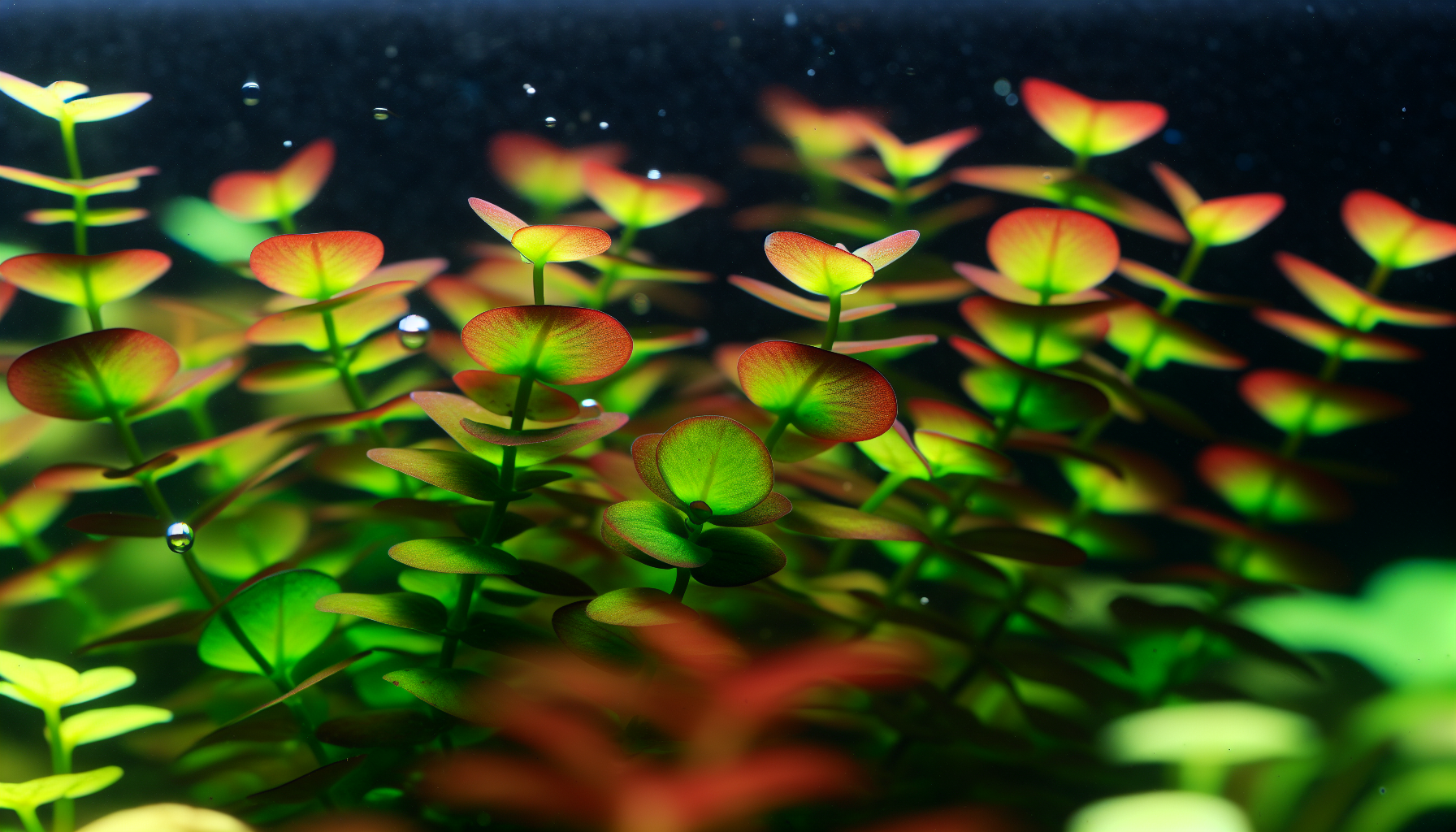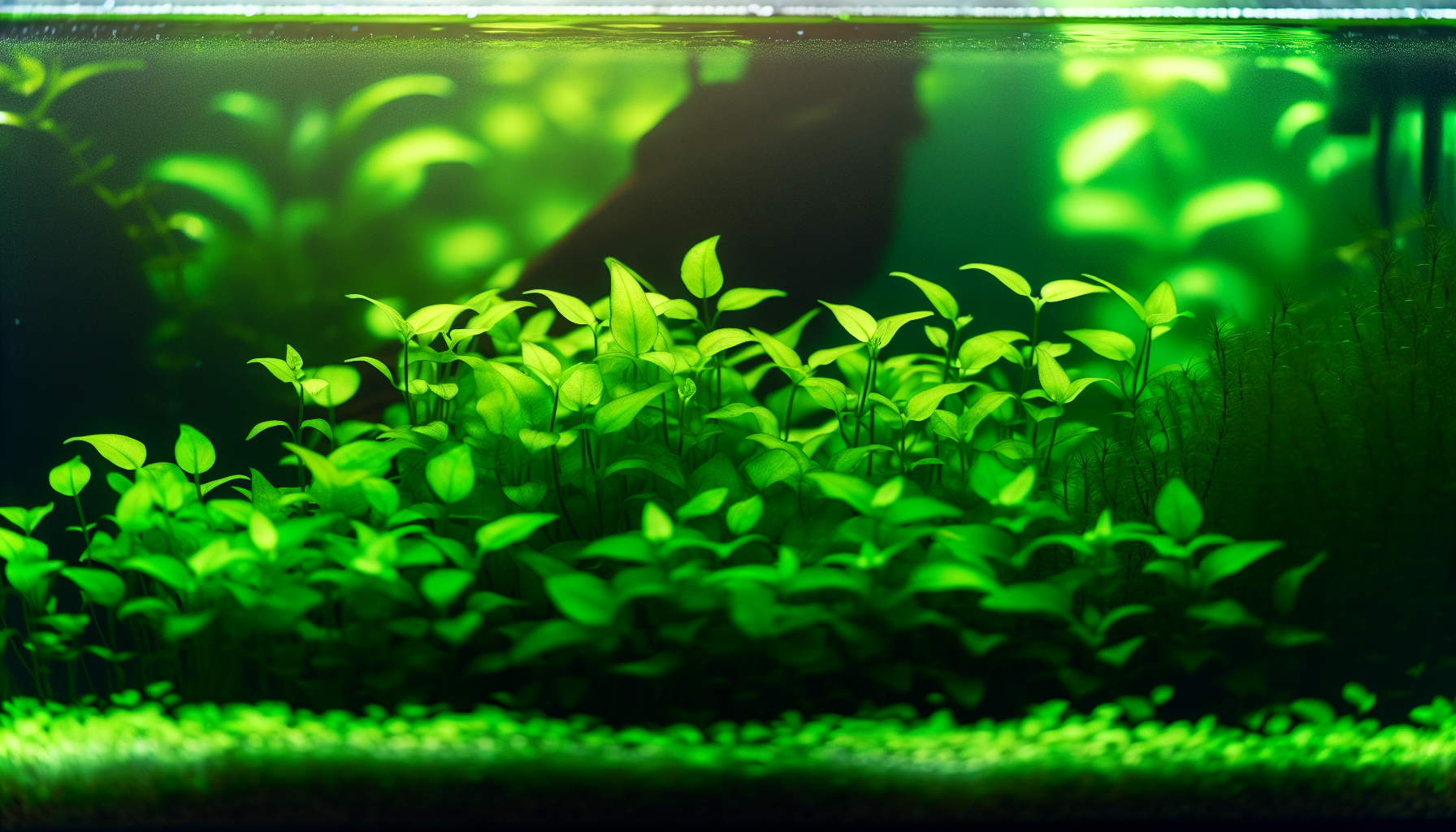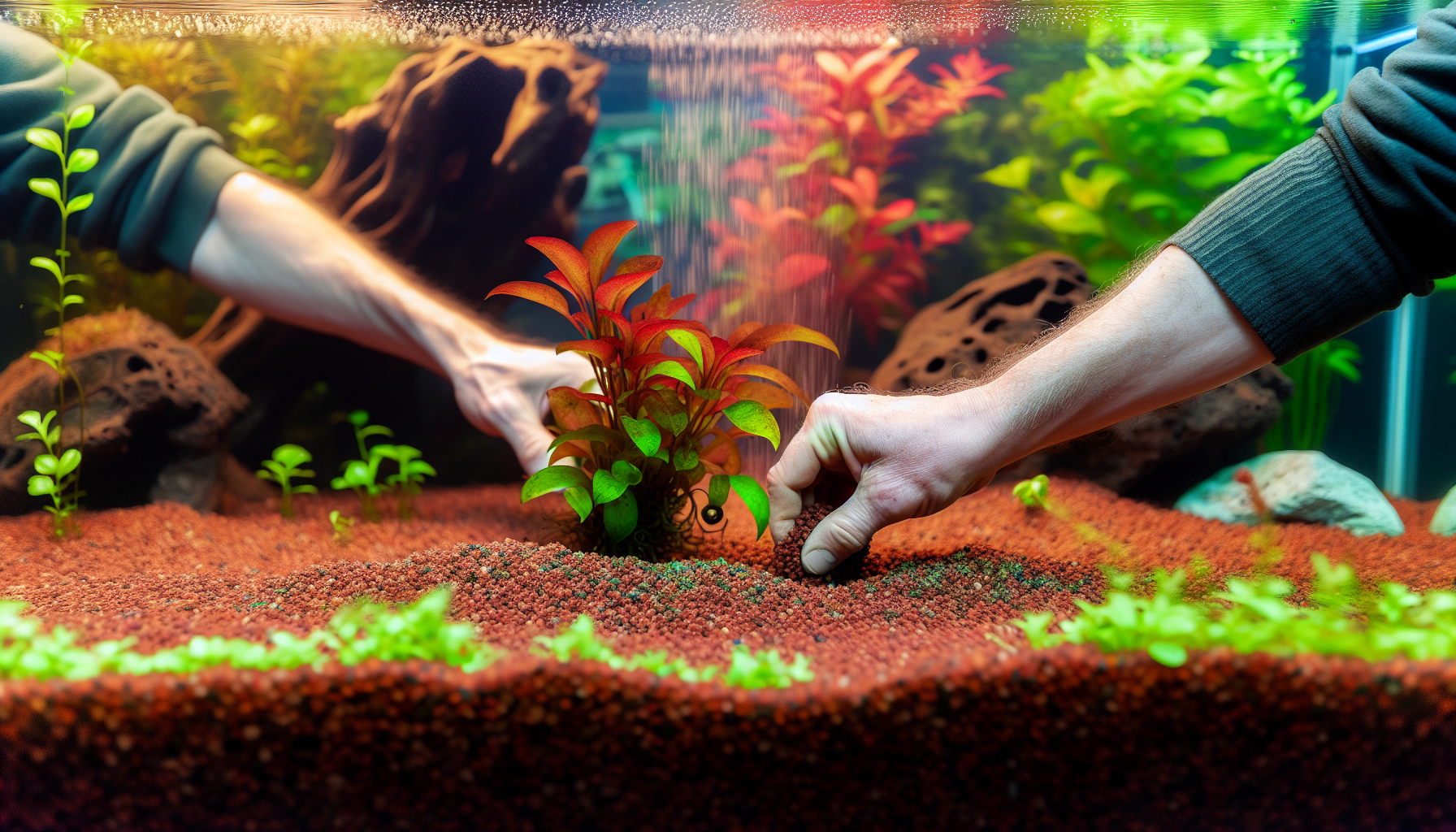Ludwigia Repens: Essential Care Tips for Thriving Healthy Aquarium Growth
Mastering the care of ‘ludwigia repens’ can transform your aquarium with its lush red foliage. What conditions does this plant need to reveal its full beauty? This concise guide offers clarity on water quality, light levels, nutrients, and more to ensure a thriving ‘ludwigia repens’ in your home aquarium.
Table of Contents
Key Takeaways
- Ludwigia Repens is a versatile aquatic plant known for its ability to thrive in diverse water conditions and lighting, offering a spectrum of vibrant colors based on light exposure.
- Ideal conditions for healthy growth include soft, slightly acidic to neutral water with a temperature range of 72-82 degrees Fahrenheit, and a tank size that allows for proper establishment and space (at least 10 gallons recommended).
- Proper lighting, regular supplementation of CO2, and consistent fertilization are crucial for maintaining the vivid coloration and robust growth of Ludwigia Repens in an aquarium environment.
Unveiling Ludwigia Repens: A Portrait of the Aquatic Plant

Ludwigia Repens is a red jewel among aquatic plants, celebrated for its vibrant colors and versatility in aquascaping. Its adaptability sees it rooted in a wide range of regions, including:
- the southern United States
- Mexico
- Asia
- Africa
- Australia
It thrives in diverse environments such as ditches, ponds, and along stream banks, especially during the warm season.
In aquarium setups, these ludwigia plants, known for their robust color and growth, can reach heights of 12–20 inches and a sprig width of about two to three inches, especially under adequate lighting.
The Basics: Species Overview and Common Names
Commonly known as Creeping Primrose-willow and Red Ludwigia, this amphibious plant owes its naming to its native habitat in North and Central America, specifically the US and Mexico. As a species, Ludwigia Repens is of North and Central American origin, with several varieties found in these regions.
Visual Guide: Leaf Color and Growth Patterns
The spectrum of leaf color ranges displayed in the leaves of Ludwigia Repens, from dark green to various shades of red, is a striking feature. The red coloration intensifies directly in response to proper lighting conditions. A beautiful red under adequate light, it can turn olive green or brownish-red under less optimal conditions. Thus, when choosing Ludwigia Repens, search for plants exhibiting a range of vibrant colors, from dark green to deep red, indicative of a healthy plant.
On the other hand, lack of proper lighting can result in Ludwigia Repens losing its vibrancy and leaf colors fading.
Setting the Stage: Ideal Aquarium Conditions for Ludwigia Repens

Creating the ideal environment for Ludwigia Repens in your aquarium is like setting the stage for a star performer. Here are some key factors to consider:
- Soft, slightly acidic water is recommended.
- The optimum growth temperature is 75–79 Fahrenheit.
- While this popular plant can adapt to various tank sizes and even thrive in nano tanks, a minimum of 10 gallons is recommended for Ludwigia Repens to truly shine.
Such provision of space facilitates its substantial growth and guarantees a robust presence in your aquarium.
Water Parameters: Temperature, pH, and Hardness
Ludwigia Repens is comfortable in a wide temperature range from 72 to 82 degrees Fahrenheit, reminiscent of tropical waters. The ideal pH range is slightly acidic to neutral, specifically between 6.5 and 7.5, although it can also handle a range of 6.0 to 7.0.
Furthermore, while Ludwigia Repens is adaptable to both soft and hard water conditions, it performs best in soft to moderate hardness, with a general hardness of 3 – 8 GH, ensuring a healthy water column for the plant’s growth.
Tank Size Recommendations: Space for Growth
When it comes to tank size, Ludwigia Repens requires a minimum of 10 gallons to allow for proper establishment and growth. To fully appreciate the potential density and height of Ludwigia Repens, tanks of 20 gallons or larger are recommended.
As a general rule, avoid placing Ludwigia Repens in tanks smaller than 10 gallons to maintain sufficient space for growth and to achieve a visually pleasing contrast within the tank.
Lighting and Nutrition: Keys to Vibrant Ludwigia Repens
Maintaining a vibrant and healthy Ludwigia Repens relies heavily on providing adequate lighting and nutrition. Despite the plant’s ability to adapt to low-tech tanks and varying lighting conditions, moderate to strong planted tank lighting is necessary to enhance the colors of Ludwigia Repens and uphold its overall health. Insufficient lighting leads to taller growth with more slender stems and less vibrant red leaves, less ideal for enthusiasts seeking lush and colorful aquascapes.
In addition to lighting, the growth rate and color vibrancy of Ludwigia Repens can be significantly enhanced by the regular addition of CO2, micronutrients, and iron-rich fertilizers.
Lighting Spectrum: From Low Light to High Lighting
The lighting spectrum plays a significant role in the health and appearance of Ludwigia Repens. Maintaining moderate lighting for 6-10 hours a day supports healthy growth and root development. Insufficient lighting can cause the plant to lose its lower leaves, emphasizing the necessity of a consistent light period for plant health.
Under low light conditions, Ludwigia Repens shows a green color, while under moderate to high lighting, it exhibits hues of red, yellow, or even purple, creating a delightful decorative effect. Bright red Ludwigia Repens varieties such as ‘Super Red’ and ‘Rubin’ require stronger light for optimal coloration compared to the original species.
Nutrient Supply: Fertilization and CO2 Requirements
Although Ludwigia Repens can grow without CO2, its growth and color vibrancy can be boosted with the addition of CO2. Iron supplementation, along with other trace elements, is crucial for achieving the bright colors and strong growth that Ludwigia Repens is capable of. To achieve the best results, include CO2 supplementation in a comprehensive care strategy that incorporates high lighting and nutrient-rich fertilizers for Ludwigia Repens.
Planting Techniques and Positioning

Some technique is required when planting Ludwigia Repens to ensure the plant’s health and growth. These plants perform best when planted in the substrate rather than being floated. Any medium to large-grained substrate can be used to anchor Ludwigia Repens in an aquarium due to its strong roots, setting a firm foundation for the plant’s health.
Substrate Selection: Foundation for Root Health
Selecting the appropriate substrate is essential to promote a healthy root system in Ludwigia Repens. Suitable substrates include Seachem Fluorite, Carib Sea Eco-Complete, and Fluval Plant & Shrimp Stratum. A medium to large-grained substrate effectively provides enough space for Ludwigia Repens roots to breathe, ensuring proper health and growth.
It’s important to avoid sandy substrates as they can suffocate the roots of Ludwigia Repens.
Strategic Placement: Background or Midground?
Strategic placement is key when positioning Ludwigia Repens in your aquarium. This plant is ideal for planting in the mid-ground or background of aquariums for an appealing visual layout. When placed towards the back of the tank, Ludwigia Repens can provide a beautiful backdrop for aquascaping due to its larger size and rapid growth. Properly trimmed, it can form an attractive back wall in an aquascape, contributing heavily to a structured and pleasing aquarium view.
Remember to space out Ludwigia Repens appropriately during planting to ensure better growth and to create a visually appealing contrast within the tank.
Propagation Practices: Multiplying Your Ludwigia Repens

The ease of propagation is one of the main attractions of Ludwigia Repens. This plant can be easily multiplied through vegetative propagation by using stem cuttings from a mature plant. The cuttings should be made near a node, which is an area on the stem where leaves are attached and where new roots are most likely to form. Leaves near the bottom of the stem cutting, particularly at the last node, should be removed to facilitate better rooting in the substrate.
Once prepared, the stem cuttings can be planted directly into the aquarium substrate, where they will develop roots and grow into new individual Ludwigia Repens plants.
Cutting Techniques: Ensuring Successful New Growth
Your method of cutting Ludwigia Repens can have a significant impact on its growth. Regular and consistent trimming is necessary to prevent the lower parts from becoming leafless and hindering plant recovery. To stimulate bushy growth, trim the plant from the bottom and replant the trimmed tops.
When you cut the tops, this initiates the growth of two new branches, which can take a few weeks to reach full size.
Managing Cuttings: Encouraging Root Development
Effective management of stem cuttings is a crucial aspect of successful propagation. For propagation, the cut stem of Ludwigia Repens should be at least 3-5 inches long, ensuring it has enough length to support new growth after replanting. The cutting should be made just below a node to increase the chances of successful rooting and sprouting of new leaves.
Before planting, follow these steps:
- Remove lower leaves from the cuttings to promote better anchorage in the substrate and minimize the risk of rot.
- Insert the cuttings into the substrate at least an inch deep to provide stability and encourage root development.
- Space multiple cuttings around 2-3 inches apart to allow adequate growth and spread without competition for resources.
Regular Pruning: How to Encourage Bushy Growth
Bushy growth in Ludwigia Repens can be encouraged through regular pruning. Here are some tips:
- The first trim should be roughly 4-6 nodes above the substrate to promote denser growth.
- On subsequent trims, prune 2-3 nodes up a branch to encourage the plant to split and form a denser stand.
- When propagating Ludwigia Repens, leave at least 2 inches of the stem with a minimum of 2 nodes to enable effective regrowth and bushy development.
Infrequent pruning can result in the lower parts of the plants becoming leafless, affecting the plant’s ability to recover.
Monitoring Health: Signs of Deficiencies and Excesses
Closely observing the health of Ludwigia Repens is imperative for its successful cultivation. Signs of deficiency include:
- Boron deficiency: small, hard, deformed new leaves that hamper leaf expansion
- Iron deficiency: white leaves, as iron is an immobile nutrient within the plant
- Potassium deficiency: older leaves develop small holes, which can lead to yellowing and eventual die-off
- Melting leaves: suggest poor health and can result from suboptimal water quality.
Excessive trace element dosing, especially with boron, can cause rapid growth in Ludwigia Repens, signaling potential toxicity. High levels of CO2 and copper, commonly found in aquarium fertilizers, can be harmful to invertebrates like shrimp that share the tank with Ludwigia Repens.
Companions and Conflicts: Ludwigia Repens in the Community Tank
Ludwigia Repens is not only a stand-alone beauty but also a cooperative participant in a community tank. However, it’s important to choose its companions wisely. Certain fish species may interact with Ludwigia Repens in ways that can harm the plants, including uprooting them or eating them.
On the other hand, shrimps and snails are compatible invertebrate tankmates as they are generally not harmful to the plants.
Friendly Flora: Compatible Aquatic Plants
Ludwigia Repens can coexist well with a variety of aquatic plants, each of which contributes to a visually appealing and healthy aquascape. It can thrive alongside green aquatic plants like Java Fern, Amazon Sword, and Rotala Rotundifolia. Anubias barteri, Hygrophila polysperma, and Bacopa caroliniana also coexist well with Ludwigia Repens, offering longevity, rapid growth, and ease of care, respectively.
Cryptocoryne wendtii and Vallisneria spiralis, both popular aquarium plant choices, provide contrasting textures and shapes, while Echinodorus bleheri complements Ludwigia Repens in larger tanks.
Cautionary Tankmates: Fish and Invertebrates to Avoid
While Ludwigia Repens gets along with most tankmates, there are some to avoid. Small, aggressive fish may attempt to eat Ludwigia Repens, damaging the leaves over time. Fish that prey on Ludwigia Repens, like Goldfish and Oscars, should be avoided as they are likely to nibble on the plants. Aggressive fish species can also damage Ludwigia Repens by tearing up the plants. Crayfish, crabs, and certain large snail species should not be kept in the same tank as they can cause harm to the plant.
High levels of CO2 and Copper present in most fertilizers can be extremely dangerous for shrimp that might be present in the tank with Ludwigia Repens.
Acquiring Ludwigia Repens: Tips for Selecting Healthy Specimens
There are a few considerations to make when acquiring Ludwigia Repens to ensure you’re bringing home a healthy specimen. Here are some tips:
- Choose plants with firm stems and vibrant leaves, as they signify the plant’s good health.
- Inspect for new growth at the nodes, since this indicates the plant is actively growing.
- Avoid plants with signs of excessive melting, damaged stems, or decaying leaves, as these may suggest poor health.
Upon acquisition, inspect Ludwigia Repens for pests and consider treating with a mild bleach dip to prevent introducing pests to the aquarium without harming the plant.
Inspection Checklist: Identifying Healthy Stems and Leaves
When examining Ludwigia Repens, search for upright and narrow stems, a trait indicative of the plant’s healthy growth pattern. The leaves should be oppositely arranged and oval, showing no signs of wilting or discoloration.
This checklist will help you identify healthy specimens and ensure that your new plant, one of the great plants available, is in excellent condition when you bring it home.
Quarantine Procedures: Preventing Disease Spread
Once you have Ludwigia Repens at home, it’s vital to prevent contamination of the main aquarium by pests, diseases, or toxic substances. Disinfecting the plant using a very mild solution of bleach, followed by a thorough rinse, can help kill any pests or pathogens present on the plant.
After disinfection, follow these steps:
- Rinse Ludwigia Repens with dechlorinated clean water.
- Quarantine the plants in a separate controlled environment for a few days.
- Monitor for signs of disease or pests.
Summary
Mastering the art of Ludwigia Repens care requires an understanding of its ideal environment, nutritional needs, planting techniques, propagation practices, and companions and conflicts in the community tank. By following the guidelines shared in this guide, you can ensure the vibrant growth and beauty of this popular aquatic plant in your aquarium. So, are you ready to embark on your Ludwigia Repens journey?
Frequently Asked Questions
Yes, Ludwigia repens can be grown either submerged or emersed, but it is easier to cultivate when planted in the substrate. Propagation can be achieved by replanting stem cuttings from the main plant.
Yes, Ludwigia Ovalis is a great option for beginner aquarium enthusiasts due to its easy care and slow-growing nature.
Yes, Ludwigia repens is considered a fast-growing plant, making it a popular choice for aquariums. It is also known as Ludwigia natans and is native to the southern USA, Mexico, and Caribbean Islands.
Ludwigia repens does not necessarily need CO2, but providing CO2 can help it grow more vigorously and maintain vibrant colors. High lighting and nutrient levels are also important for its health and appearance.



 Shrimp
Shrimp Fish
Fish Crab &
Crab & Plants
Plants Foods
Foods Snails
Snails